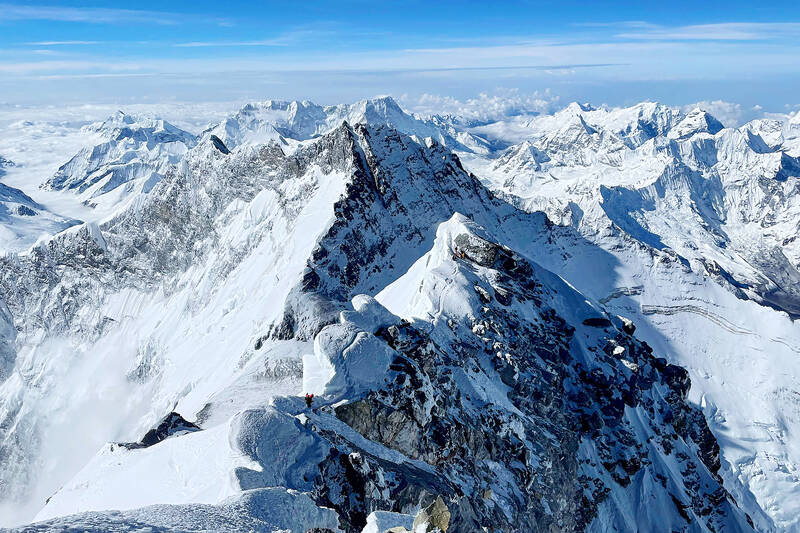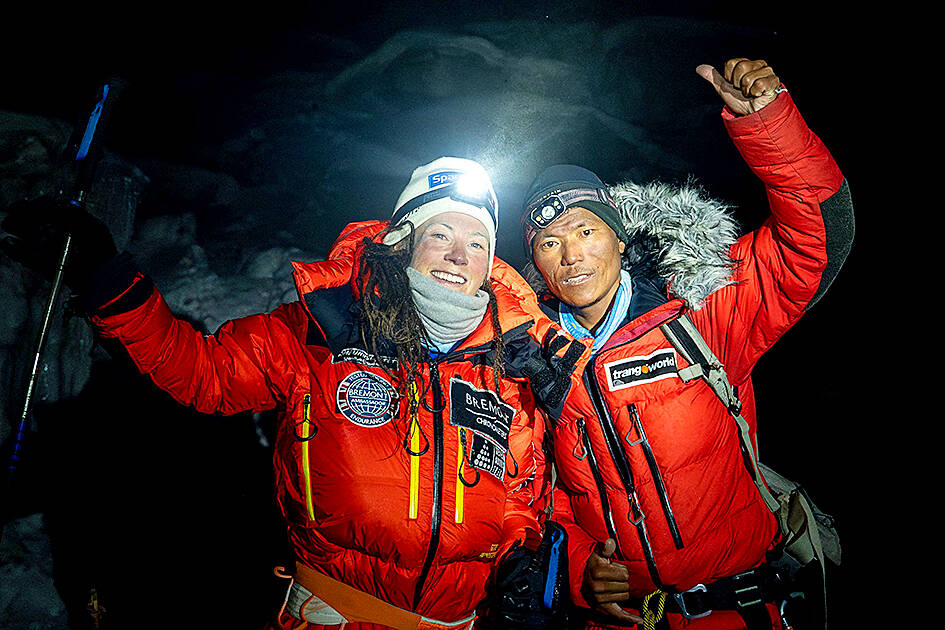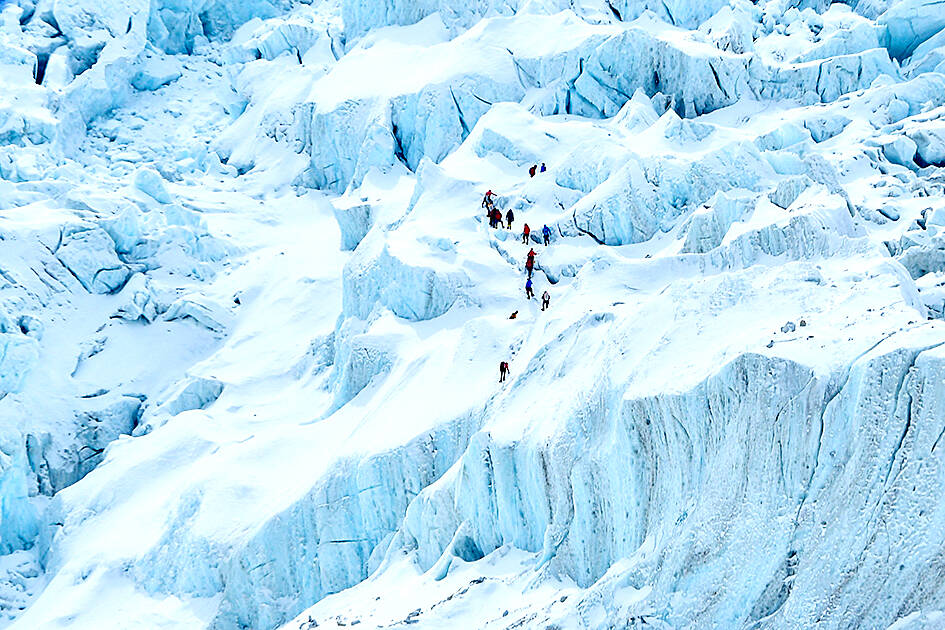A record number of climbers are gathered in Tibet to complete mountaineering’s pinnacle achievement, summiting the world’s tallest 14 peaks.
Only about 50 climbers have climbed all mountain peaks above 8,000 meters, a feat that took most years, or even decades, to complete.
About 20 are vying for the record books this month, some spurred by a blockbuster Netflix documentary giving the endeavor a wider profile.

Photo: AFP
Technological advancements have made the feat easier to accomplish.
“We are growing as a community, and we are representing mountaineering all over the world,” said Pakistani climber Shehroze Kashif, 22.
“I think that’s great... they are completing their dream, as I am.”

Photo: AFP
It took Italian climber Reinhold Messner 16 years from his initial summit to become the first person in the world considered to have climbed all 14 peaks in 1986.
But most of the climbers assembled in the Chinese Himalayas at the base camp of Mount Shisha Pangma only began their attempts within the past few years.
They have already summited the 13 other highest peaks, located in the Himalayan and Karakoram ranges, straddling Nepal, Pakistan, Tibet and India.

Photo: AFP
Many have been waiting to scale the 8,027-meter-high Tibetan peak since last year, when China closed the mountain to climbers after two American women and their Nepali guides were killed in an avalanche.
‘MOUNTAINS ATTRACT THEM’
The aspirants are a mix of seasoned veterans and rising stars.

Photo: AFP
Teenage Nepali climber Nima Rinji Sherpa, 18, aims to be the youngest to climb all 14.
Several hope to be the first from their respective countries to accomplish the feat.
Advances in mountaineering technology, weather forecasting and logistical support have made this once-inaccessible goal more achievable — particularly for those who can afford it.
Mingma Sherpa of Seven Summit Treks, Nepal’s biggest mountaineering expedition company, said that climbers could expect to pay up to US$700,000 for full support teams.
But he said the hefty price tag had not dissuaded a growing number of people from pursuing the endeavor.
“They climb one or two, and then the mountains attract them,” he said. “Soon they might decide to climb them all.”
Teams of support crews and helicopters for rapid transportation between base camps have allowed climbers to tackle multiple mountains in a single season.
“It is clear that the pioneers back then, they did much more difficult, dangerous and exceptional ascents,” said German mountaineering chronicler Eberhard Jurgalski.
“Now it is possible to do them within three months. The logistics are so world-class now.”
British-Nepali climber Nirmal Purja famously completed the 14 peaks in just over six months in 2019, shattering the previous record of seven years.
His efforts were chronicled in a Netflix documentary, inspiring a new wave of athletes to try and eclipse his speed run.
Norwegian climber Kristin Harila and her Nepali guide Tenjen Lama Sherpa — the latter who died attempting to summit Shisha Pangma last year — now hold the record.
They climbed the giant mountains in 92 days, ending in July last year. The pair also reached the “true summits” of all the mountains, which many previous climbers had missed.
This month, at least six have already completed the feat after summiting Shisha Pangma, including the first Japanese, Pakistani and female American climbers.
They also included Nirmal Purja again, who this time said he was climbing all 14 without supplementary oxygen.
‘ANOTHER CHALLENGE’
The trend towards speed has not always been welcomed by the mountaineering fraternity. Veteran climbers have criticized Purja and Harila for using helicopters, pre-prepared routes and support teams.
Dawa Yangzum Sherpa, who is aiming to become the first woman from Nepal to summit all 14 peaks, said the style of ascent dictated how much it was valued by other alpinists.
“Some... don’t have the capacity to climb without support,” she said.
But Russian climber Alina Pekova, also attempting the Tibetan summit to finish her 14-peak climb, said that speed ascents were an endurance test.
“If you can climb it a fast way, why not try?” she said. “That’s another challenge.”

In recent weeks the Trump Administration has been demanding that Taiwan transfer half of its chip manufacturing to the US. In an interview with NewsNation, US Secretary of Commerce Howard Lutnick said that the US would need 50 percent of domestic chip production to protect Taiwan. He stated, discussing Taiwan’s chip production: “My argument to them was, well, if you have 95 percent, how am I gonna get it to protect you? You’re going to put it on a plane? You’re going to put it on a boat?” The stench of the Trump Administration’s mafia-style notions of “protection” was strong

Late last month US authorities used allegations of forced labor at bicycle manufacturer Giant Group (巨大集團) to block imports from the firm. CNN reported: “Giant, the world’s largest bike manufacturer, on Thursday warned of delays to shipments to the United States after American customs officials announced a surprise ban on imports over unspecified forced labor accusations.” The order to stop shipments, from the US Customs and Border Protection (CBP), came as a surprise to Giant, company officials said. Giant spokesman Ken Li (李書耕) said that the CPB never visited the company’s factories to conduct on-site investigations, nor to interview or

Every now and then, it’s nice to just point somewhere on a map and head out with no plan. In Taiwan, where convenience reigns, food options are plentiful and people are generally friendly and helpful, this type of trip is that much easier to pull off. One day last November, a spur-of-the-moment day hike in the hills of Chiayi County turned into a surprisingly memorable experience that impressed on me once again how fortunate we all are to call this island home. The scenery I walked through that day — a mix of forest and farms reaching up into the clouds

“Eighteen years ago, people didn’t even know the name of this ingredient,” says 58-year-old Gil Sa-hyeon, holding up a cluster of dried brownish stems. “Now it’s everywhere.” His shop, Joseon Yakcho, sits in the heart of Seoul’s Yangnyeongsi Market, South Korea’s largest traditional medicinal herb market, its streets lined with shops displaying buckets of herbs such as licorice root and cinnamon bark that spill on to the pavements, filling the air with their distinct, earthy aroma. The ingredient Gil is referring to is hovenia dulcis, known in Korean as heotgae — the oriental raisin tree that’s become the cornerstone of South Korea’s